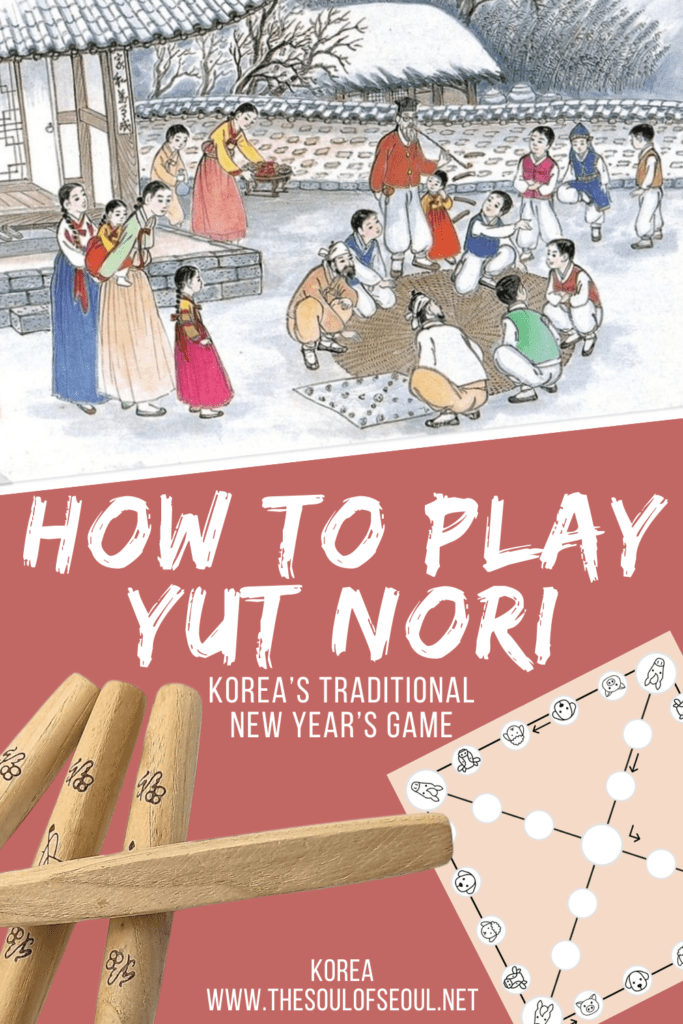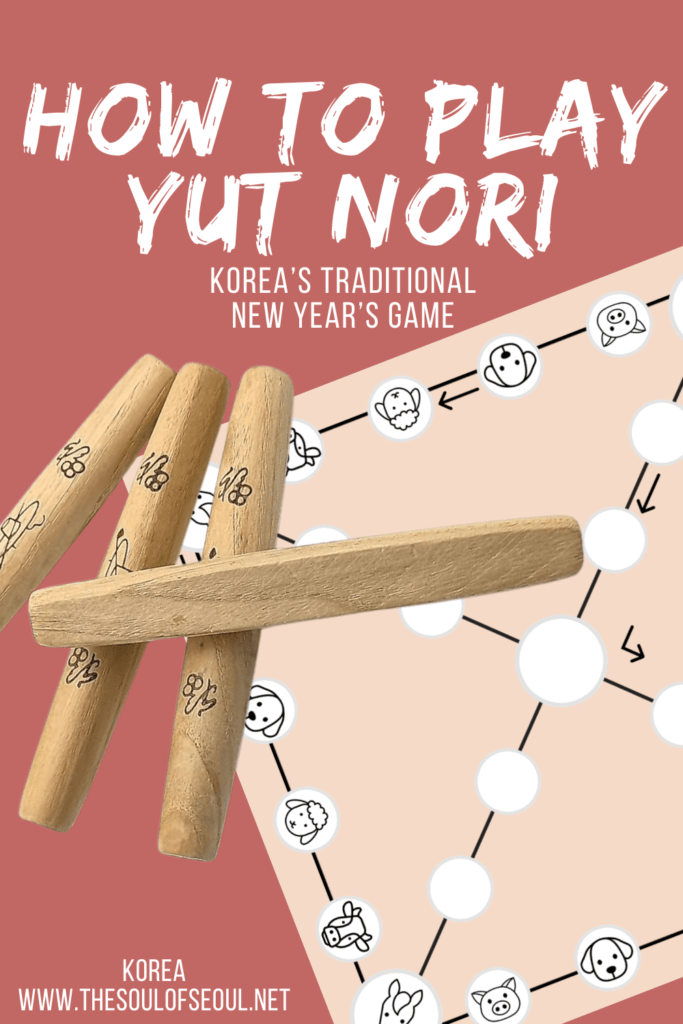How To Play Yut Nori: Korea’s Traditional New Year’s Game
Last Updated on December 27, 2023
If you live in Korea and stay through a traditional Korean holiday, chances are high that you will come across the traditional Korean game known as yut nori (윷노리). Even if you’re not celebrating with a family, you can find the game played at schools, yut nori sets can be found at folk museums, and you can even find sets in local toy stores.
Yut nori is a fun Korean game and if you’re looking for something fun to do this Lunar New Year with your kids, this is a great game that you can also prepare yourself at home.

Yut nori is a fun traditional Korean game that weaves together history, strategy, and cultural significance. Ready to find out more?
(This post contains affiliate links, which means I receive a certain percentage of a sale if you purchase after clicking at no cost to you. Thank you for your support.)
Cultural context and history
Yut Nori, deeply rooted in Korea’s Three Kingdoms Period (57 BCE – 668 CE), holds a fascinating history and while you’ve probably come here to learn how to play, there’s a lot more you can learn about yut nori than you might realize.
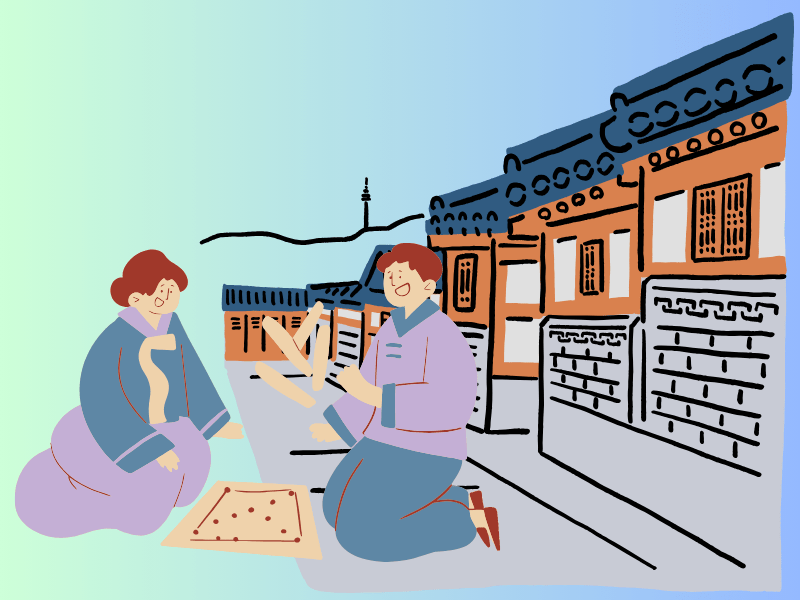
Though its exact origins are uncertain, there are historical records from Korea, China, and Japan that mention yut nori. Chae Ho-shin, a Korean historian, has also claimed the game descents from the Korean Kingdom Gojoseon in 2333BC. Petroglyphs from the Joseon era and mentions in the eighth-century collection of songs, Manyo syu, showcase its enduring presence.
The next time you visit an art museum in Seoul or folk museum, be sure to look closely at the historic Korean paintings and you’ll probably be able to see at least one with people playing yut nori.
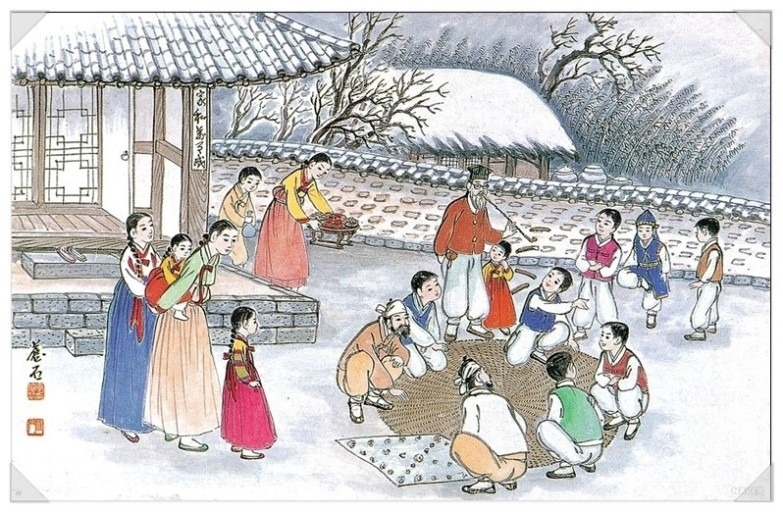
Traditionally the most popular during Seollal, or Lunar New Year, and Jeongwol Daeboreum celebrations, beyond entertainment, the game is also said to predict the future. The historical record, the Yeolyangsesigi, warns of dire consequences for crops if played beyond the fifteenth day. This intriguing connection suggests Yut Nori wasn’t just a game; it was deeply intertwined with Lunar New Year rituals.
Yutnori’s symbolic origin
Yut nori reflects the heavens, earth, and the rhythms of nature. The yut sticks, with flat and round sides symbolizing yin and yang, mirror the counterclockwise movement of the Big Dipper stars.
Yutnori’s leftward direction signifies a departure from daily life, aligning with East Asian astronomy and embracing the sanctity of the game. Its incorporation in tombstones symbolizes celestial aspirations, expressing wishes to the heavens.
The five key moves – do (도, pig), gae (개, dog), geol (걸, sheep), yut (윷, cow), and mo (모, horse) – according to Ilyeon’s interpretation, represent the five tribes of the Gojoseon era.
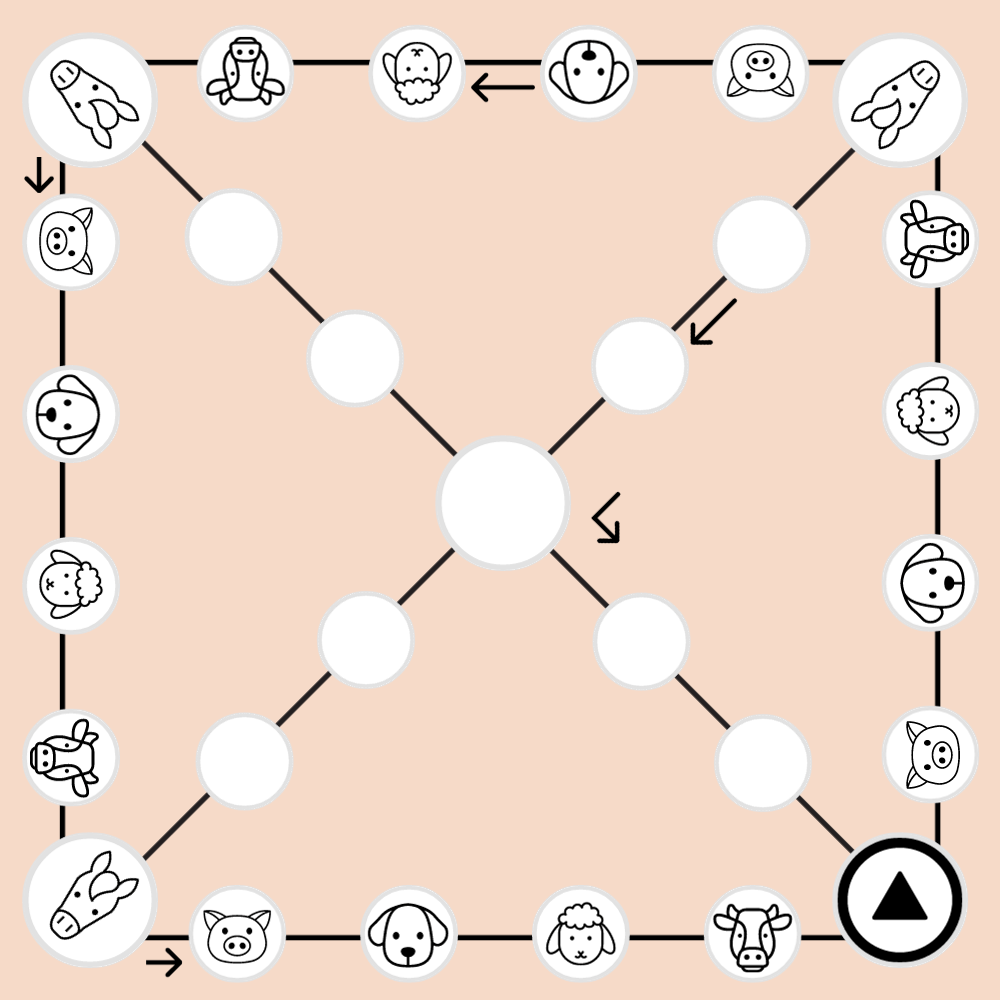
Yut Nori Set
Delving into the yut nori set reveals a carefully crafted board known as mal-pan (말판), traditionally made of stitched cloth. Modern versions sport a rectangular shape, while historical variations included a round board. With four straight and two diagonal courses, totaling 29 stations, the board lays the foundation for this strategic journey.
Yut sticks, replacing traditional dice, come in two types: jang-jak yut (장작 윷), made of firewood, and bam yut (밤 윷), which are smaller sticks shaken in a bowl. Tokens, or “mals,” serve as game pieces, with diverse materials like coins, buttons, or chess beads, adding a touch of personalization to the game.
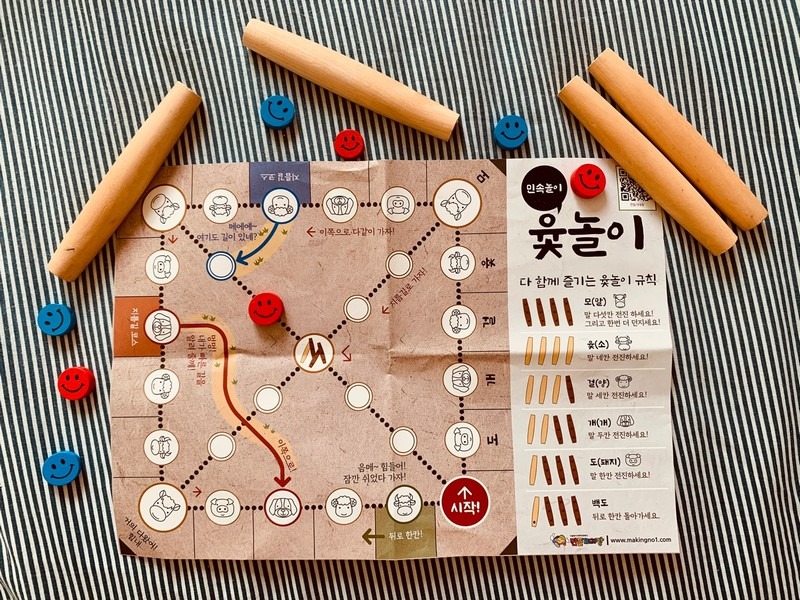
Buy Yut Nori Online
Traditional Yut Nori Board Game: There’s a great option on Amazon that features a board with the more traditional circular shape with a beautiful Korean dancheong design on the pieces.
Make it yourself
The great thing about yut nori is that even if you’ve just suddenly wondered what to do to celebrate Seollal with kids, the Lunar New Years, you can recreate this pretty quickly yourself.
- Recreate the board: Check out the board above and draw it yourself.
- Find some mal: Decide what you want to use for game pieces. Make two sets of four matching pieces that can be moved around the board. You could use four pennies for one team and four nickels for the other team. You could also just use paper. Just make sure you can stack them on top of each other.
- Make the yut: Traditional yut should have one flat side and one curved side, but in a pinch, you can just use popsicle sticks, or something similar. Draw on one side of each stick so you know which side is up and which side is down. If you have kids, you might get them to help you prep this part too.
How to play yut nori
Game Pieces:
- Game board
- Four yut sticks
- Two sets of four mal, or game tokens.
How many players: 2 people or 2 teams
The game unfolds on a board adorned with 29 spaces, where each team, armed with four pieces, maneuvers based on the outcomes of tossing four yut sticks. Victory is claimed by the team that skillfully advances all their pieces to the board’s end and removes them. The strategy involves moving pieces separately or together, showcasing a delicate blend of chance and skill.
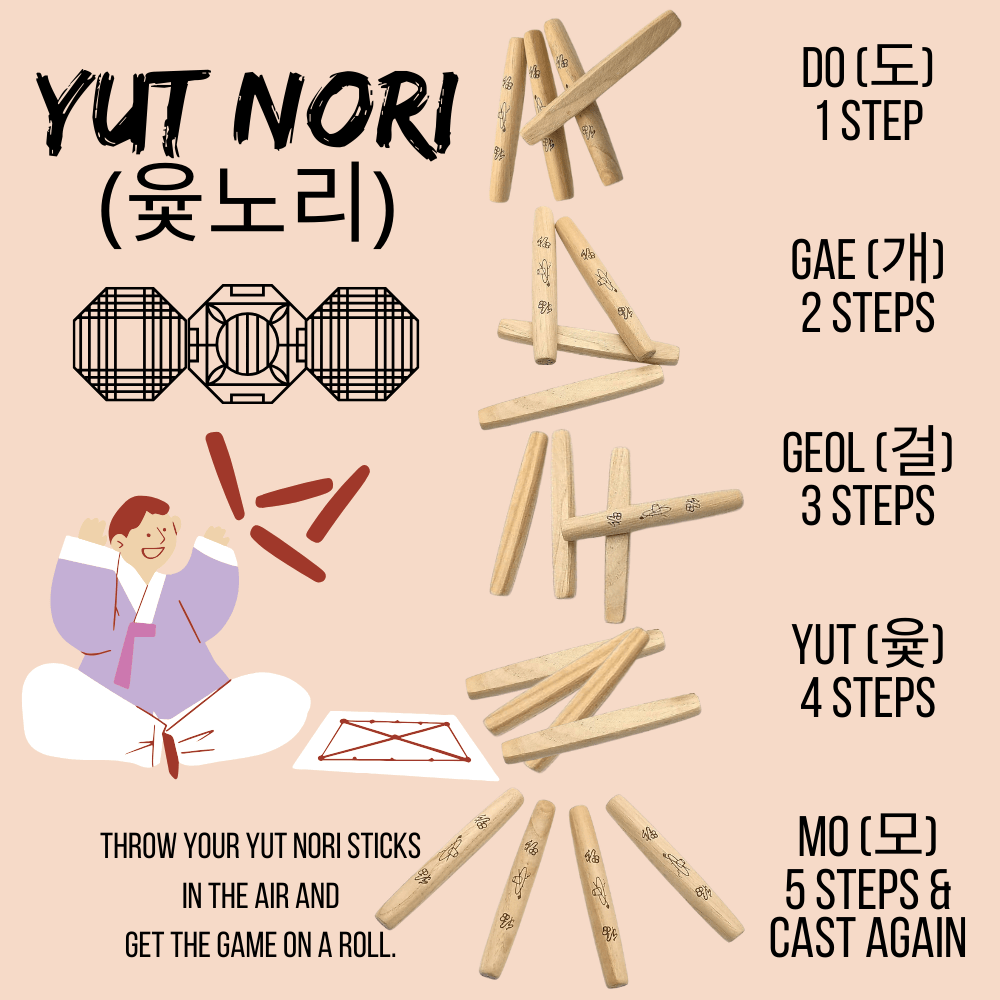
- To play, you first throw the four sticks into the air and allow them to land in front of you.
- The sticks are heavy and can be loud when they drop so if you’re inside, lay a towel down on the floor to throw them onto.
- You can choose to move a mal that is already on the board, or you can choose to start a new mal.
- Count how many blank sides of the yut sticks are face up and that is the number of spaces to move your piece. If there are no blank sides, you get to move 5 spaces.
- If your piece ends up on a space that is already occupied by the other team, send their mal on that space back to the start.
- If your piece ends up on a space that is occupied by your own mal, they become a group and can travel together.
- In order to use the shortest routes or “cut through” the board, you need to land exactly on the larger circles and then you can move on the shortest path on the next move. This means there are four possible routes to get your mal to the end.

- If you throw a yut or a mo, ie all sticks are either face up or all are face down, you get an extra turn. There is no limit to how many turns in a row a player can have as long as they continue to throw yut or mo.
- To get your mal safe and around the board, you need to have a roll that takes your piece beyond the start space.
Special rules, like the Seoul and Busan rules, enhance gameplay, adding strategic twists. If you want to add them, here are the extra rules to play with.
- The Seoul Rule: Label one stick in the set with “Seoul (서울)” on the flat/blank side. If this stick is the only one facing down (do so that the letters Seoul can be read), a mal can be placed directly into the center circle, which in this case is called Seoul. If all the mals are already on the course, this counts as a do.
- The Busan Rule: Label one stick in the set with “Busan (부산)” on the flat/blank side. The Busan rule is similar. Rather than to the center, the mal travels directly to the far corner (mo). Again, this only applies if this is the only stick facing down, and not all mals are on the course already.
- The Back Rule: Label one stick in the set with one of the sticks with “back (후퇴)” on the flat/blank side. If this is the only stick facing down, one of the mals has to go back one step. Depending on the rules used, if none of the mals are on the course, then this is counted as either a do or a skipped turn.
In essence, yut nori is more than just a game; it’s a cultural journey that unveils Korea’s rich history, strategic prowess, and a deep connection to celestial symbolism.
Did you like this post? Pin IT!
